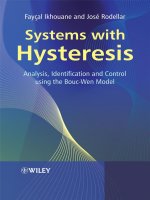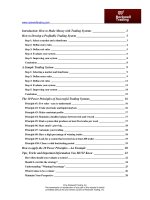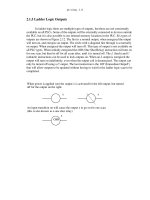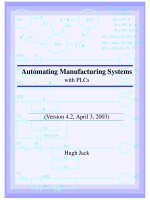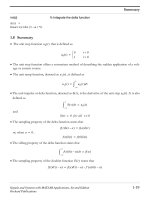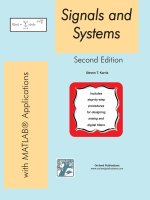building winning trading systems with tradestation - wiley
Bạn đang xem bản rút gọn của tài liệu. Xem và tải ngay bản đầy đủ của tài liệu tại đây (4.41 MB, 406 trang )
TEAMFLY
Team-Fly
®
Building Winning
Trading Systems with
TradeStation
™
Founded in 1807, John Wiley & Sons is the oldest independent publishing
company in the United States. With offices in North America, Europe, Australia
and Asia, Wiley is globally committed to developing and marketing print and
electronic products and services for our customers’ professional and personal
knowledge and understanding.
The Wiley Trading series features books by traders who have survived the
market’s ever changing temperament and have prospered—some by reinventing
systems, others by getting back to the basics. Whether a novice trader,
professional, or somewhere in between, these books will provide the advice and
strategies needed to prosper today and well into the future.
For a list of available titles, please visit our Website at www.WileyFinance.com.
Building Winning
Trading Systems with
TradeStation
™
George Pruitt
John R. Hill
FUTURES TRUTH
John Wiley & Sons, Inc.
Copyright © 2003 by George Pruitt and John R. Hill. All rights reserved.
Published by John Wiley & Sons, Inc., Hoboken, New Jersey
Published simultaneously in Canada
No part of this publication may be reproduced, stored in a retrieval system, or transmitted in
any form or by any means, electronic, mechanical, photocopying, recording, scanning, or
otherwise, except as permitted under Section 107 or 108 of the 1976 United States Copyright
Act, without either the prior written permission of the Publisher, or authorization through
payment of the appropriate per-copy fee to the Copyright Clearance Center, Inc., 222
Rosewood Drive, Danvers, MA 01923, 978-750-8400, fax 978-750-4470, or on the web at
www.copyright.com. Requests to the Publisher for permission should be addressed to the
Permissions Department, John Wiley & Sons, Inc., 111 River Street, Hoboken, NJ 07030,
201-748-6011, fax 201-748-6008, e-mail:
Limit of Liability/Disclaimer of Warranty: While the publisher and author have used their
best efforts in preparing this book, they make no representations or warranties with respect to
the accuracy or completeness of the contents of this book and specifically disclaim any implied
warranties of merchantability or fitness for a particular purpose. No warranty may be created
or extended by sales representatives or written sales materials. The advice and strategies
contained herein may not be suitable for your situation. You should consult with a
professional where appropriate. Neither the publisher nor author shall be liable for any loss of
profit or any other commercial damages, including but not limited to special, incidental,
consequential, or other damages.
For general information on our other products and services, or technical support, please
contact our Customer Care Department within the United States at 800-762-2974, outside
the United States at 317-572-3993 or fax 317-572-4002.
Wiley also publishes its books in a variety of electronic formats. Some content that appears in
print may not be available in electronic books.
For more information about Wiley products, visit our web site at www.wiley.com.
Designations used by companies to distinguish their products are often claimed as trademarks.
In all instances where John Wiley & Sons, Inc. is aware of a claim, the product names appear
in initial capital or all capital letters. Readers, however, should contact the appropriate
companies for more complete information regarding trademarks and registration.
Library of Congress Cataloging-in-Publication Data:
Pruitt, George, 1967–
Building winning trading systems with TradeStation
™
/ George Pruitt, John R. Hill.
p. cm. — (the Wiley trading series)
Includes index.
ISBN 0-471-21569-4 (cloth: alk. paper)
1. Investments—Data processing. 2. Stocks—Data processing. I. Hill, John R.,
1926– II. Title. III. Series.
HG4515.95.P78 2002
332.64'2'02855369—dc21
Printed in the United States of America
10987654321
To my loving wife and family.
J. H.
I would like to dedicate this book to Mary, Cliff, Butch, and
Marilyn for their eternal courage and support. I would also
like to thank my loving wife, Leslie and my patient and
understanding children, Brandon and Emily.
G. P.
vii
Contents
Acknowledgments xi
Introduction xiii
Chapter 1 Fundamentals 1
What is EasyLanguage? 1
Variables and Data Types 2
Operators and Expressions 5
Precedence of Operators 6
TradeStation 2001i versus TradeStation 6.0 8
TradeStation 2000i 9
PowerEditor 9
A Simple Program 11
TradeStation StrategyBuilder 13
TradeStation 6.0 18
PowerEditor 18
A Simple Program 22
Conclusions 29
Chapter 2 EasyLanguage Program Structure 30
Structured Programming 30
Program Header 31
Calculation Module: MyRSIsystem 32
Conclusions 37
Chapter 3 Program Control Structures 39
Conditional Branching with If-Then 39
Conditional Branching with If-Then-Else 43
Repetitive Control Structures 48
For Loop 48
While Loop 50
Conclusions 51
Chapter 4 TradeStation Analysis Techniques 52
Indicators 52
PaintBar and ShowMe Studies 59
Functions 65
Strategies 70
Conclusions 75
Chapter 5 Measuring Trading System Performance and System
Optimization 77
TradeStation’s Summary Report 78
Total Net Profit 81
Maximum Intraday Draw Down 82
Account Size Required and Return on Account 82
Average Trade 83
Maximum Consecutive Winners and Losers 84
Number of Trades and Average Number of Bars Per Trade 84
Average Winning and Losing Trade 84
Trades 85
Analysis 88
Graphs 93
Optimization 96
Conclusions 108
Chapter 6 Trading Strategies That Work
(or The Big Damn Chapter on Trading Strategies) 109
The King Keltner Trading Strategy 111
King Keltner Pseudocode 112
King Keltner Program 112
King Keltner Summary 114
The Bollinger Bandit Trading Strategy 115
Bollinger Bandit Pseudocode 116
Bollinger Bandit Program 116
Bollinger Bandit Summary 118
The Thermostat Trading Strategy 119
Thermostat Pseudocode 121
viii Contents
Thermostat Program 122
Thermostat Summary 123
The Dynamic Break Out II Strategy 126
Dynamic Break Out II Pseudocode 127
Dynamic Break Out II Program 128
Dynamic Break Out II Summary 130
The Super Combo Day Trading Strategy 134
Super Combo Daily Data Bar Calculation Pseudocode 139
Super Combo Code 143
Super Combo Summary 146
The Ghost Trader Trading Strategy 149
Ghost System Code 150
Real System Code 151
The Money Manager Trading Stragegy 153
The Money Manager Code 154
Conclusions 156
Chapter 7 Debugging and OutPut 157
Logical Versus Syntax Errors 158
Debugging with the Print Statement and Print Log 158
Table Creator 160
Conclusions 166
Chapter 8 TradeStation as a Research Tool 168
Commitment of Traders Report 168
Day of Week Analysis 176
Open to Close and Open to Open Relationships 176
Day of Week Volatility Analysis 177
Time of Day Analysis 183
Pattern Recognition 188
Intermarket Analysis 192
Conclusions 193
Chapter 9 Using TradeStation’s Percent Change Charts to Track
Relative Performance 194
Working with Percent Change Charts 196
Conclusions 200
Chapter 10 Options 201
Option Basics 202
Listed Options 204
Nomenclature and Terminology 205
Long and Short 206
Contents
ix
Closing Option Trades 209
American Versus European Options 210
The Special Properties of Options 210
Volatility Trading 212
Options and Changing Conditions 212
The Greeks 213
Who Are Market Makers? 214
Option Strategies 215
Single-Option Strategies 216
Long Call 216
Short Covered Call 217
Short Naked Call 218
Long Call with Short Stock 220
Long Put 220
Short Covered Put 222
Short Naked Put 222
Long Put with Long Stock 223
Equivalent Strategies 224
Combinational Strategies 225
Chapter 11 Interviews with Developers 228
Welles Wilder 228
Dr. John Clayburg 232
Keith Fitschen 235
Randy Stuckey 238
Dave Fox 241
Wayne Griffith 243
Mike Barna 247
Ziad Chahal 250
John Tolan and Steve Marshall 254
John Ehlers 258
Charles Le Beau 262
Lundy Hill 265
Peter Aan 267
Michael Chisholm 270
Michael A. Mermer 273
A Talk with Larry Williams by Rob Keener 276
Appendix A EasyLanguage Syntax Errors 283
Appendix B TradeStation 2000i Source Code of Select Programs 309
Appendix C Reserved Words Quick Reference 326
Index 381
x Contents
TEAMFLY
Team-Fly
®
xi
Acknowledgments
We would like to thank TradeStation Securities, OptionVue software, and Jan
Arps and Len Yates for their contributions.
xiii
Introduction
Before System Writer (the grandfather of today’s current TradeStation), sys-
tem developers and traders did not have a commercialized software platform to
develop their trading ideas. We are not talking about charting packages; we are
talking about programs that could understand a trading strategy based on tech-
nical analysis. Sure, there were other sophisticated programs in the 1980s that
could be used, but they required a thorough understanding of programming,
additional software, and extreme patience with the software developer. Most of
these programs were not open platform; you had to program within their lim-
ited scripting language and could not share your programs with others. The
programs that were potentially open platform usually required a separate edi-
tor and compiler and a very sophisticated user. In fact, we developed and still
use a package that is based on a FORTRAN compiler. The System Writer/
TradeStation programs provided one sleek package that gave the ability to
test, optimize, and trade to the trading masses. TradeStation has been accepted
worldwide as the premier market analysis platform and the standard against
which other trading/testing platforms are measured. The latest version of
TradeStation has evolved into more than just software; it is a fully self-
contained trading platform that incorporates direct access brokerage for
futures and equities traders. Along with the birth of TradeStation 6.0, Omega
Research has been reborn and renamed to TradeStation Securities.
We are not here to proclaim TradeStation’s Securities products to be the
best in the business, but we are here to educate their users on how to use what
is accepted as the industry standard. Of course Omega Research has had their
problems; all software developers have had their problems. Recently, it was
heard that the inventor of the CTRL + ALT + DEL key sequence at IBM
stated that he may have created it, but Microsoft made it famous. What sets
TradeStation apart from the other software packages is its powerful scripting
language EasyLanguage. EasyLanguage is more powerful than easy; it really
isn’t a scripting language, but more of a full-blown programming language. It
can be compared to BASIC, FORTRAN, Pascal, or C. In fact, it is based off of
a Pascal compiler and has been around since 1987. Sam Tennis, the father of
EasyLanguage, wanted to provide traders with a simple and logical language
that required little programming knowledge. In our opinion, he was successful
in this endeavor.
Technical analysis of stocks and commodities is complex and you would
think that a programming language that deals with such a lofty subject would
be as complex. Fortunately, EasyLanguage comes with a complete library of
the industry’s most widely used analysis techniques. Third-party developers
have further extended this library. Traders do not need to recreate the wheel,
nor do they need the programming knowledge to put these techniques into
action. Traders can even customize their own ideas or existing ones and add
them to the library.
This book is designed for all TradeStation and EasyLanguage users.
However, this book does expect users to be somewhat familiar with TradeSta-
tion and its functions. Beginners can obtain a good foundation on program-
ming technique, program control structures, data structures, and
familiarization on the use of the EasyLanguage built-in functions. All users will
benefit from the chapters that discuss proper trading system development. We
explore all areas of analysis techniques from Indicators to Paint Bars with a spe-
cial emphasis on trading strategies.
Since a large portion of this book involves actual computer code, a com-
panion CD-ROM, with all of the computer programs and data, is provided for
the reader. The analysis techniques are provided in TradeStation 2000i and
TradeStation 6.0 formats. Previous version users can still utilize the analysis
techniques by simply typing them into their version of PowerEditor. Chapter
5 enlists the help of Microsoft Excel spreadsheet software to create three-
dimensional contour charts. Excel isn’t necessary, but some type of spreadsheet
software is needed to transform the data into a chart.
This book was designed with the trader in mind. Most of the trading
techniques were designed and tested with indices, futures, and commodities
(we focused on these markets due to their long histories with trading systems).
Strictly equity traders will still get a good programming and good system
design education. Index (mini or full-size) and futures traders will be privy to
five highly successful trading approaches. These approaches are good launch-
ing pads for further and much more detailed research.
In our opinion, the best way to make full use of this book is for the reader
to work his way through the book starting with Chapter 1. At the end of chap-
ters that have detailed analysis techniques (or computer programs—the two terms
xiv
Introduction
are interchangeable), we would suggest loading from the CD-ROM, verifying,
and running the programs in TradeStation. The concepts of each chapter
should be mastered before moving on to the next chapter.
We hope you (the reader) enjoy this book and that it opens your eyes to
the power of TradeStation and your own creativity. Good luck and good
trading.
Introduction xv
1
1
Fundamentals
WHAT IS EASYLANGUAGE?
When you code (slang for writing your ideas into a programming language) an
analysis technique, you are directing the computer to follow your instructions
to the tee. A computer program is nothing but a list of instructions. A com-
puter is obedient and speedy, but it is only as smart as its programmer. In addi-
tion, the computer requires that its instructions to be in an exact format. A
programmer must follow certain syntax rules.
EasyLanguage is the medium used by traders to convert a trading idea
into a form that a computer can understand. Fortunately for nonprogrammers,
EasyLanguage is a high level language; it looks like the written English lan-
guage. It is a compiled language; programs are converted to computer code
when the programmer deems necessary. The compiler then checks for syntac-
tical correctness and translates your source code into a program that the
computer can understand. If there is a problem, the compiler alerts the pro-
grammer and sometimes offers advice on how to fix it. This is different than a
translated language, which evaluates every line as it is typed.
All computer languages, including EasyLanguage, have several things in
common. They all have:
• Reserved Words. Words that the computer language has set aside for a
specific purpose. You can only use these words for their
predefined purposes. Using these words for any other
purpose may cause severe problems. (See the list of
reserved words in Appendix C.)
• Remarks. Words or statements that are completely ignored
by the compiler. Remarks are placed in code to help
the programmer, or other people who may reuse the
code, understand what the program is designed to do.
EasyLanguage also utilizes skip words. These words are
included in a statement to make the programming eas-
ier to read. For example, Buy on next bar at myPrice
stop is the same as Buy next bar myPrice stop. The words
on and at are completely ignored. (See the list of skip
words in Appendix C.)
• Variables. User-defined words or letters that are used to store
information.
• Data Types. Different types of storage; variables are defined by
their data types. EasyLanguage has three basic data
types: Numeric, Boolean, and String. A variable that is
assigned a numeric value, or stored as a number, would
be of the Numeric type. A variable that stores a true or
false value would be of the Boolean type. Finally, a
variable that stores a list of characters would be of the
String type.
Variables and Data Types
A programmer must understand how to use variables and their associated data
types before they can program anything productive. Let’s take a look at a snip-
pet of code.
mySum = 4 + 5 + 6;
myAvg = MySum/3;
The variables in this code are mySum and myAvg and they are of the Numeric
data type; they are storage places for numbers. EasyLanguage is liberal con-
cerning variable names, but there are a few requirements. A variable name
cannot
• start with a number or a period (.)
• be a number
• be more than 20 alphanumeric characters long
• include punctuation other than the period (.) or underscore (_)
2
Building Winning Trading Systems with TradeStation
Correct Incorrect
myAvg 1MyAvg
mySum .sum
sum val+11
val1 the//sum
the.sum my?sum
my_val 1234
Variable naming is up to the style of the individual programmer. EasyLan-
guage is not case sensitive (you can use upper or lowercase letters in the
variable names). (Note: This is our preference—may not be everybody’s.)
Lowercase letters are preferred for names that only contain one syllable. For
variable names that have more than one syllable, we begin the name with a
lowercase letter and then capitalize the beginning of each subsequent syllable.
sum, avg, total, totalSum, myAvg, avgValue, totalUpSum, totDnAvg
Still referring to the previous snippet of code, mySum is assigned the value of
15 and myAvg is assigned the value of 15/3 or 5. If a variable name is created,
it must be declared ahead of time. The declaration statement defines the initial
value and data type of the variable. The compiler needs to know how much
space to reserve in memory for all variables. The following code is a complete
EasyLanguage program. (Note: Most of the code that you will see in this book
will be particular to EasyLanguage and will probably not work in any other
language.)
Vars: mySum(0),myAvg(0);
mySum = High + Low + Close ;
myAvg = mySum/3 ;
The Vars: (or Variables:) statement tells the computer what variables are being
declared and initialized. We declare the variables by simply listing them in the
Vars statement and initialize them by placing an initial value in parentheses fol-
lowing the variable name. In this case, mySum and myAvg are to be equal to
zero. EasyLanguage is smart enough to realize that these variables should be of
the Numeric data type, since we initialized them with numbers. Variable
names should be self-descriptive and long enough to be meaningful. Which of
the following is more self-explanatory?
mySum = High+Low+Close; or k = High + Low + Close;
myAvg = mySum/3; j = k/3;
BuyPt = Close + myAvg; l = Close+j;
Fundamentals 3
Variables of Boolean and String types are declared in a similar fashion.
Vars: myCondition(false),myString("abcdefgh");
The variable myCondition was initialized to false. The word false is a reserved
word that has the value of zero. This word cannot be used for any other pur-
pose. The variable myString was initialized to abcdefgh. Sometimes you will
need to use a variable for temporary purposes and it is difficult to declare and
initialize all of your variables ahead of time. In the case of a temporary variable
(one that holds a value for a short period of time), EasyLanguage has declared
and initialized several variables for your use; value0 through value99 have been
predefined and initialized to zero and are ready for usage in your programs.
The following is a complete EasyLanguage program:
value1 = High + Low + Close;
value2 = (High + Low)/2.0;
Notice there isn’t a Vars statement. Since value1 and value2 are predefined, the
statement isn’t needed. You have probably noticed the semicolon (;) at the end
of each line of code. The semicolon tells the compiler that we are done with
this particular instruction. In programming jargon, instructions are known as
statements. Statements are made up of expressions, which are made up of con-
stants, variables, operators, functions, and parentheses. Some languages need a
termination symbol and others do not. EasyLanguage needs the statement ter-
mination symbol. Remember to put a semicolon at the end of each line to pre-
vent a syntax error.
Inputs are similar to variables. They follow the same naming protocol
and are declared and initialized. However, an input remains constant
throughout an analysis technique. An input cannot start a statement (a line of
instruction) and cannot be modified within the body of the code. One of the
main reasons for using inputs is that you can change input values of applied
analysis techniques without having to edit the actual EasyLanguage code.
Inputs would be perfect for a moving average indicator. When you plot this
indicator on a chart, you simply type in the length of the moving average into
the input box of the dialog box. You don’t want to have to go back to the mov-
ing average source code and change it and then verify it. Also, when used in
trading strategies, inputs allow you to optimize your strategies. This is dis-
cussed in Chapter 5.
Notice how inputs and variables are declared in similar style.
Inputs: length1(10),length2(20),flag(false);
Vars: myLength1(10),myAvgVal(30);
However, notice how they are used differently in coding.
4
Building Winning Trading Systems with TradeStation
TEAMFLY
Team-Fly
®
Variables
myLength1 = myAvgVal + myLength1; {Correct}
Inputs
length1 = myAvgVal + length1; {Incorrect}
myLength1 = length1*2; {Correct}
Variables can start a statement and can be assigned another value. Since inputs
are constants and cannot be assigned new values, they cannot start a statement.
In a strongly typed language, such as C, Pascal, or C++, if you assign a real
value such as 3.1456 to an integer typed variable, the decimal portion is trun-
cated and you end up with the number 3. As we all know, precision is impor-
tant when it comes to trading, so EasyLanguage includes only one Numeric
type. All numbers are stored with a whole and a fractional part. In the old days
when CPUs were slow, noninteger arithmetic took too much time and it was
advised to use integer variables whenever possible.
OPERATORS AND EXPRESSIONS
Previously, we discussed statements and how they are made up of expressions.
To review, an expression consists of a combination of identifiers, functions,
variables, and values, which result in a specific value. Operators are a form of
built-in functions and come in two forms: unary and binary. A binary operator
requires two operands, whereas a unary operator requires only one. Most of
your dealings with operators in EasyLanguage will be of the binary variety.
Some of the more popular ones are: + – / * < = > >= <= <> AND OR. These
binary operators can be further classified into two more categories: arithmetic
and logical.
Expressions come in three forms: arithmetic, logical, and string. The type
of operator used determines the type of expression. An arithmetic expression
includes + – / *, whereas a logical or Boolean expression includes < = > >= <=
<> AND OR.
Arithmetic Expressions Logical Expressions
myValue = myValue + 1; myCondition1 = sum > total;
myValue = sum – total; myCondition1 = sum <> total;
myResult = sum*total+20; cond1 = cond1 AND cond2
Arithmetic expressions always result in a number, and logical expressions
always result in true or false. True is equivalent to 1, and False is equivalent to
0. String expressions deal with a string of characters. You can assign string val-
ues to string variables and compare them.
Fundamentals 5
myName1 = "George Pruitt";
myName2 = "John Hill";
cond1 = (myName1 <> myName2);
myName3 = myName1 + " " + myName2;
Concatenation occurs when two or more strings are added together. Basically,
you create one new string from the two that are being added together.
PRECEDENCE OF OPERATORS
It is important to understand the concept of precedence of operators. When
more than one operator is in an expression, the operator with the higher prece-
dence is evaluated first and so on. This order of evaluation can be modified
with the use of parentheses. EasyLanguage’s order of precedence is as follows:
1. Parentheses
2. Multiplication or division
3. Addition or subtraction
4. <, >, =, <=, >=, <>
5. AND
6. OR
Here are some expressions and their results:
1. 20 – 15/5 equals 17 not 1
20 – 3 division first, then subtraction
2. 10 + 8/2 equals 14 not 9
10 + 4 division first then addition
3. 5 * 4/2 equals 10
20/2 division and multiplication are equal
4. (20 – 15)/5 does equal 1
5/5 parentheses overrides order
5. (10 + 8)/2 equals 9
18/2 parentheses overrides order
6. 6 + 2 > 3 true
8 > 3
7. 2 > 1 + 10 false
2 < 11
6
Building Winning Trading Systems with TradeStation
8. 2 + 2/2 * 6 equals 8 not 18
2 + 1 * 6 division first
2 + 6 then multiplication
8 then addition
These examples have all the elements of an arithmetic expression—numeric
values and operators—but they are not complete EasyLanguage statements. An
expression must be part of either an assignment statement (myValue = mySum
+ myTot) or a logical statement (cond1 = cond2 OR cond3).
The overall purpose of EasyLanguage is to translate an idea and perform
an analysis on a price data series over a specific time period. A price chart con-
sists of bars built from historical price data. Each individual bar is a graphical
representation of the range of prices over a certain period of time. A five-
minute bar would have the Opening, High, Low, and Closing prices of an
instrument over a five-minute time frame. A daily bar would graph the range
of prices over a daily interval. Bar charts are most often graphed in an Open,
High, Low, and Close format. Sometimes the opening price is left off. A can-
dlestick chart represents the same data, but in a different format. It provides an
easier way to see the relationship between the opening and closing prices of a
bar chart. Other bar data such as the date and time of the bar’s close, volume,
and open interest is also available for each bar. Since EasyLanguage works
hand-in-hand with the charts that are created by TradeStation, there are many
built-in reserved words to interface with the data. These reserved words were
derived from commonly used verbiage in the trading industry. You can inter-
face with the data by using the following reserved words. (Note: Each word has
an abbreviation and can be used as a substitute.)
Reserved Word Abbreviation Description
Date D Date of the close of the bar.
Time T Time as of the close of the bar.
Open O Open price of the bar.
High H High price of the bar.
Low L Low price of the bar.
Close C Close price of the bar.
Volume V Number of contracts/shares traded.
OpenInt OI Number of outstanding contracts
(futures only).
If you wanted to determine that the closing price of a particular instrument was
greater than its opening price you would simply type: Close > Open, or, C > O.
Fundamentals 7
The beauty of EasyLanguage is its ability to have all of the data of an instru-
ment at your fingertips. The reserved words that we use to access the different
prices of the current bar are also used to access historical data. You do this by
adding an index to the reserved word. The closing price of yesterday would be:
Close[1]. The closing price two days ago would be: Close[2] and so on. The
number inside the bracket determines the number of bars to look back.
The larger the number, the further you go back in history. If you wanted to
compare today’s closing price with the closing price ten days prior you would
type: Close > Close[10].
Before we move on, we should discuss how TradeStation stores dates and
times. January 1, 2001 is stored as 1010101 instead of 20010101 or 010101.
When the millennium changed, instead of incorporating the century into the
date, TradeStation simply added a single digit to the year. The day after
991231 was 1000101 according to TradeStation. Time is stored as military
time. For example, one o’clock in the afternoon is 1300 and one o’clock in the
morning is 100.
After that brief introduction to the world of programming, let’s go ahead
and set up and program a complete trading strategy. The PowerEditor is
where all of the magic takes place. This is your interface between your ideas
and their applications. All of your coding takes place here, and a thorough
understanding of this editor will reduce headaches and increase productivity.
In TradeStation 4.0 and 2000i, the PowerEditor is basically a stand-alone
application; it is an independent program and can be run with or without
TradeStation. In the newer TradeStation 6.0, the PowerEditor is more of a
component program; it runs within the confines of TradeStation.
TRADESTATION 2000i VERSUS
TRADESTATION 6.0
As of the writing of this book, there are two versions of TradeStation currently
being used: 2000i and 6.0. Based on input from users, we figure that half is
using one version and the other half is using the other. For this reason, the
remainder of this chapter will be broken into two main sections. (Beyond this
chapter, however, we will include the EasyLanguage code for 2000i in Appen-
dix B. We will concentrate on 6.0 in the remaining chapters as it is the latest
version and seems to be the way of the future.) Version 6.0 and 2000i are dif-
ferent enough to merit treating each one separately and we will refer to the two
versions as 6.0 and 2000i. TradeStation 6.0 is Omega Research’s all-inclusive
trading tool. Everything that you need to design, test, monitor, and execute an
analysis technique is in one slick and complete package. Omega Research is
now a brokerage/software company and equities and futures trades can be exe-
cuted through direct access with TradeStation.
8
Building Winning Trading Systems with TradeStation
